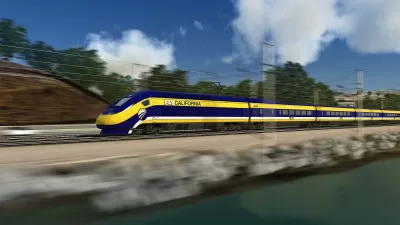A major environmental lawsuit against the High Speed Rail Authority brought by Central Valley farmers and other parties was settled on April 18, clearing the way for initial construction to begin on the 30 mile corridor between Madera and Fresno.
KQED printed the press release also available as a PDF on the rail authority's webpage.
This settlement agreement brings to an end the final California Environmental Quality Act lawsuit challenging the Merced to Fresno project section Environmental Impact Report. The agreement provides for the preservation of important farmland and mitigation of effects of high-speed rail construction on agricultural operations.
Julliet Williams of The Associated Press also wrote of the settlement. Her piece was widely covered in the media including The Huffington Post. She included an additional development - a setback for the rail authority. The Surface Transportation Board, a division of the U.S. Dept. of Transportation, ruled that it has jurisdiction over the $68 billion, 800-mile California project, meaning potential setbacks for the authority as it has additional regulations. The authority had applied for an exemption.
[Note: See Huffington Post Video: Update on President Obama's high speed rail stimulus Investments - that appears at the bottom of the article].
Sharon Bernstein of Reuters writes, "With the lawsuits settled, the state is now free to begin purchasing land for the first leg, said Lisa Marie Alley, a spokeswoman for the High Speed Rail Authority."
With the settlement, construction is set to begin this summer for the southern part of the initial, 60-mile Merced-to-Fresno segment.
This is the second development in this court case. The farming parties had asked last October for an injunction to halt all work in the corridor until the April hearing, but the judge denied the request.
The authority won a crucial victory in March in another contested corridor - the San Francisco Peninsula, when it rejected a 2008 lawsuit brought by Atherton, Menlo Park, and Palo Alto that had forced the Authority to redo their environmental impact report.
They are not out of the legal woods yet though. Robert Cruickshank writes in the California High Speed Rail Blog of a remaining suit brought by "Kings County, farmer John Tos and Hanford resident Aaron Fukuda (who) charge that the rail authority’s plans are illegal under Proposition 1A, the $9.9 billion high-speed rail bond measure approved by California voters in 2008. That suit, which hopes to block the sale of bonds, will be heard in Sacramento in late May."
Stay tuned. While the rail authority is batting really well, the game isn't over.
FULL STORY: California Bullet Train Lawsuit Dropped

Maui's Vacation Rental Debate Turns Ugly
Verbal attacks, misinformation campaigns and fistfights plague a high-stakes debate to convert thousands of vacation rentals into long-term housing.

Planetizen Federal Action Tracker
A weekly monitor of how Trump’s orders and actions are impacting planners and planning in America.

Chicago’s Ghost Rails
Just beneath the surface of the modern city lie the remnants of its expansive early 20th-century streetcar system.

Bend, Oregon Zoning Reforms Prioritize Small-Scale Housing
The city altered its zoning code to allow multi-family housing and eliminated parking mandates citywide.

Amtrak Cutting Jobs, Funding to High-Speed Rail
The agency plans to cut 10 percent of its workforce and has confirmed it will not fund new high-speed rail projects.

LA Denies Basic Services to Unhoused Residents
The city has repeatedly failed to respond to requests for trash pickup at encampment sites, and eliminated a program that provided mobile showers and toilets.
Urban Design for Planners 1: Software Tools
This six-course series explores essential urban design concepts using open source software and equips planners with the tools they need to participate fully in the urban design process.
Planning for Universal Design
Learn the tools for implementing Universal Design in planning regulations.
planning NEXT
Appalachian Highlands Housing Partners
Mpact (founded as Rail~Volution)
City of Camden Redevelopment Agency
City of Astoria
City of Portland
City of Laramie



























